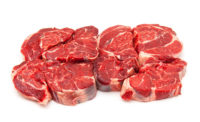The Virginia Tech-sponsored Meat Science Center processes 10,000 pounds of meat a year, which a traditional plant probably makes in half a shift. However, it’s a witness to coming trends in the ground beef industry – automation, traceability, and convenience – while educating future meat scientists and butchers.
“We can’t compare to large companies,” notes Jordan Wicks, meat lab manager, Virginia Tech, based in Blacksburg, Va. “But we still offer product to consumers every day and follow the same food safety guidelines.” The student-run, USDA-approved meat processing plant and butcher shop partners with a local farm system for its product, and supplies a large amount of meat to the campus dining halls.
Ground beef processing is fairly automated, compared to other proteins. “Plants are pretty straightforward with processing ground beef: They have grinders, conveyor belts to move product from one place to another, and machines that pump product out to be shaped and given texture, dropped into a tray and packaged,” says Wicks. “They are already very automated, and in the future, they will continue to be because automation helps alleviate food safety concerns.”
In addition, robust traceability programs exist even within small-scale companies. “Traceability programs – even for smaller facilities – track the animal from the farm to lot number and on,” notes Wicks.
Taking things a step further, blockchain technology, or the ability to track cattle through the supply chain using digital tracking technology, is another useful but still relatively new tool. Ranches such as Flying Diamond Beef in Nebraska are using implanted Bluetooth sensors to track their steers’ health and proof of life through the supply chain. The ranch is also using technology from other companies for facial recognition and analysis and genomic testing for unique identification.
Nurture Ranch in Texas is using its own Nurture Tracker technology to trace and share where and how its animals were raised, fed, and processed.
“Moving forward, ground beef processing will continue to look at and follow consumer trends to give consumers what they want,” notes Wicks. If consumers want more convenient packaging, traceability, scanning on their phones, accessibility, and transparency, then consumers and processors will move these priorities forward.
Indeed, the Virginia Tech Meat Science Center receives many calls from consumers about its product, such as where its animals come from, notes Wicks. Customers ask if the cattle was grass-fed, supplied grains, given hormones, etc. “We train our students to answer consumers’ questions and let them know we are safely producing high-quality products,” says Wicks.
FOR MORE INFORMATION, VISIT THE FOLLOWING SUPPLIERS:
AmTrade Systems
GEA North America
Handtmann Inc.
Nowicki USA
Provisur Technologies
Reiser
Rome Grinding Solutions
ScottPec Inc.
Walton’s Inc.
Packaging convenience
Smaller package sizes are trending as well today. Consumers are more interested in 1-pound versus 2-pound packaging, packages with only two to six patties, and smaller products like sliders in different sizes, notes Wicks.
“Versatility in packaging is an innovative way to move product,” he notes. “More bulk packaging can then be offered during the holidays.”
Ground beef is always in high demand for its flexibility, but pre-made patties and seasoned ground beef will also make up more ground beef products in the future, says Wicks.
“Processors should focus on what the consumer wants: more transparency, options or variety, and convenience,” says Wicks.
Keeping it local
Small, local niche markets are another growing area for ground beef products, which is a new consumer base that’s formed since the pandemic started.
“The main supermarkets’ shelves were empty in town, and they came to us for our production, processing, and ability to retain their customers,” says Wicks.
Increasingly, consumers want a local connection to their food, so this market should continue to grow.









